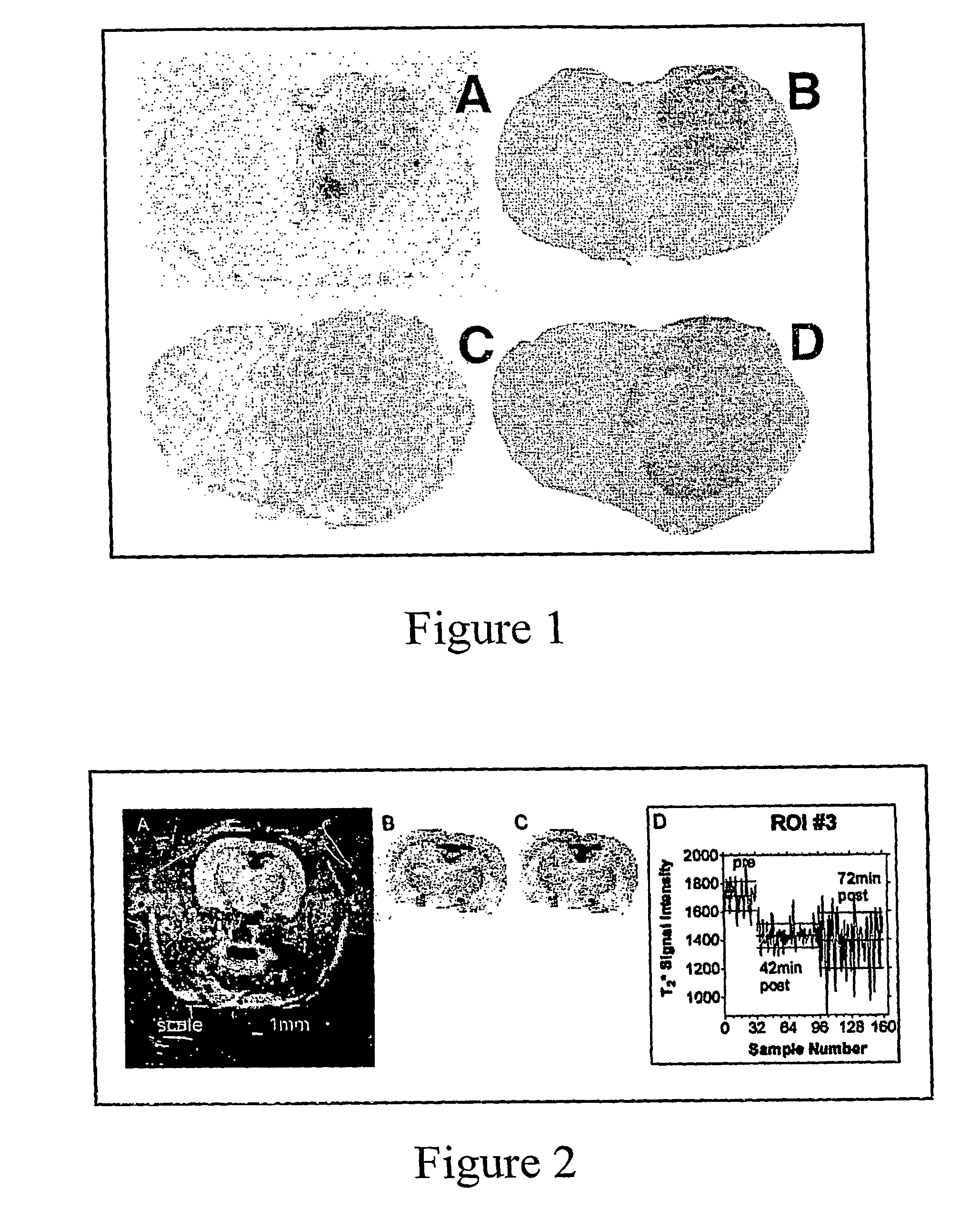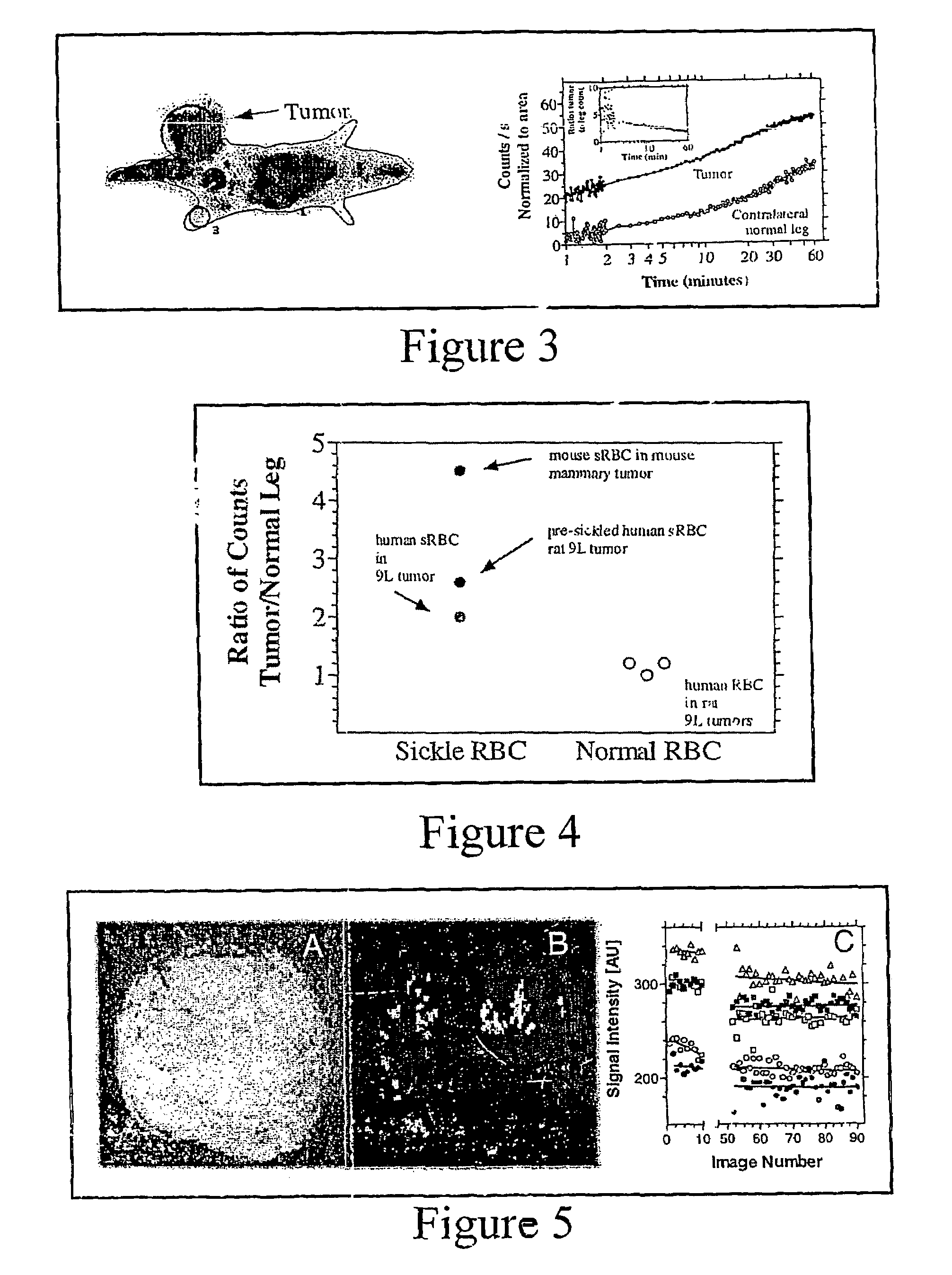Imaging and targeting tumors using sickle cells
a technology of sickle cell and tumor, applied in the field of delivery vehicles, can solve the problems of limited radiation therapy effectiveness, no routine technique available to target tumor tissue, and no routine clinical tool specifically applicable to imaging tumor hypoxia
- Summary
- Abstract
- Description
- Claims
- Application Information
AI Technical Summary
Benefits of technology
Problems solved by technology
Method used
Image
Examples
examples
[0040]In the following examples, red blood cells from patients with sickle cell anemia are shown to preferentially aggregate in tumor regions using cells labeled with fluorescence, radioactivity, or loaded with Gd-DTPA. In all cases, control cells from normal patients do not show statistically significant preferential aggregation in tumor tissue.
[0041]Various techniques are utilized to demonstrate the preferential aggregation of sickle red blood cells in tumor regions. For sickle red blood cells labeled with fluorescence, laser scanning confocal microscopy is used. For sickle red blood cells labeled with radioactivity, a nuclear medicine imaging or an autoradiography technique is utilized. Finally, sickle red blood cells loaded with Gd-DTPA are analyzed using nuclear magnetic resonance imaging. Additionally, through the use of functional magnetic resonance imaging, sickle red blood cells are shown to aggregate in tumor regions, particularly the hypoxic regions of the tumors.
General ...
example one
Nuclear Medicine Imaging
[0047]Radiolabeled sickle cells can be imaged relatively non-invasively using nuclear medicine imaging. FIG. 3 illustrates an example of the resulting image from a clinical scintillation scanner following the intravenous administration of human sickle cells to a rat with a large 9L tumor implanted in its right leg. Radioactivity increases sharply over the first several minutes and continues to increase more slowly over the next hour. The highest activity is found in regions of the rat corresponding to the tumor and some normal tissues, for example, the spleen or liver. Regions of interest are drawn around the liver, spleen, bladder, normal leg muscle, and tumor in order to monitor changes in radioactivity as a function of time. The results are shown in FIG. 3.
[0048]FIG. 3b demonstrates preferential accumulation of sickle cells in tumor immediately. Furthermore, the temporal data shown in FIG. 3b suggests that further accumulation in the tumor over the next ho...
example two
Laser Scanning Confocal Microscopy
[0052]Preferential aggregation of sickle cells to tumor is observed in rats when sRBC (0.5 ml packed) are labeled with fluorescence (Oregon Green 488 conjugated to a streptavidin-biotin complex that binds to RBC surface proteins (biotinoyl-amino-hexanoic acid, sulfosuccinimidyl ester; Molecular Probes, Inc., Eugene Oreg.) and delivered through the femoral vein one hour before sacrifice. Vasculature is visualized by injecting another fluorescence compound, Evans Blue, which conjugates to albumin in vivo. Evans Blue (2 mls per kg of a 2% w / v solution) is delivered within 10 seconds of sacrificing the rats. Of note is that the distribution of sRBCs within the tumor is not uniform. Some regions, particularly the periphery, sequestered extremely high activity, indicating sickle red blood cells preferentially aggregate to particular regions in a tumor (number of studies, n=9). Congested sRBCs are even visible on bright field (FIG. 6). Normal RBCs did not ...
PUM
| Property | Measurement | Unit |
|---|---|---|
| Therapeutic | aaaaa | aaaaa |
Abstract
Description
Claims
Application Information
 Login to View More
Login to View More - R&D
- Intellectual Property
- Life Sciences
- Materials
- Tech Scout
- Unparalleled Data Quality
- Higher Quality Content
- 60% Fewer Hallucinations
Browse by: Latest US Patents, China's latest patents, Technical Efficacy Thesaurus, Application Domain, Technology Topic, Popular Technical Reports.
© 2025 PatSnap. All rights reserved.Legal|Privacy policy|Modern Slavery Act Transparency Statement|Sitemap|About US| Contact US: help@patsnap.com



